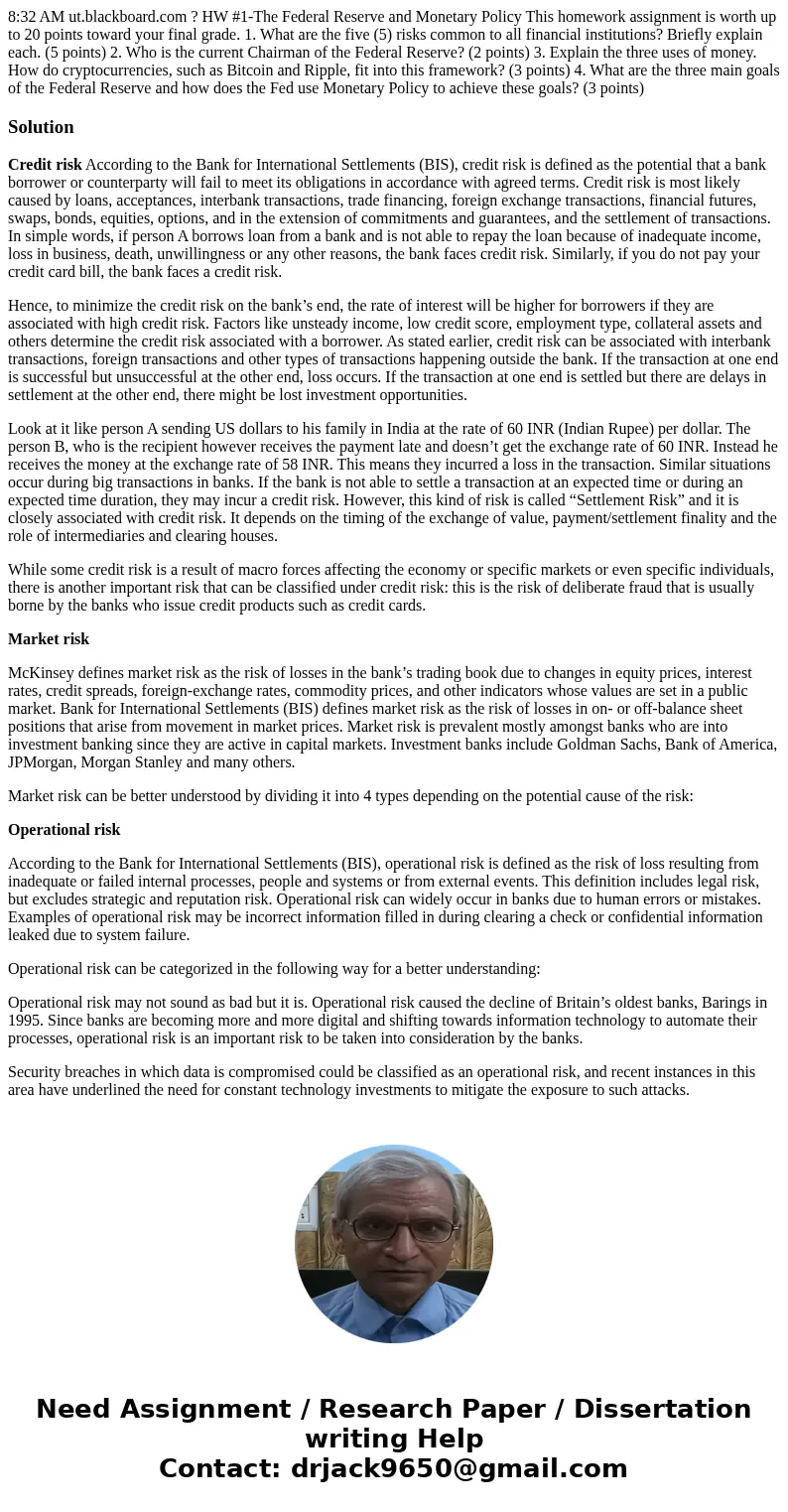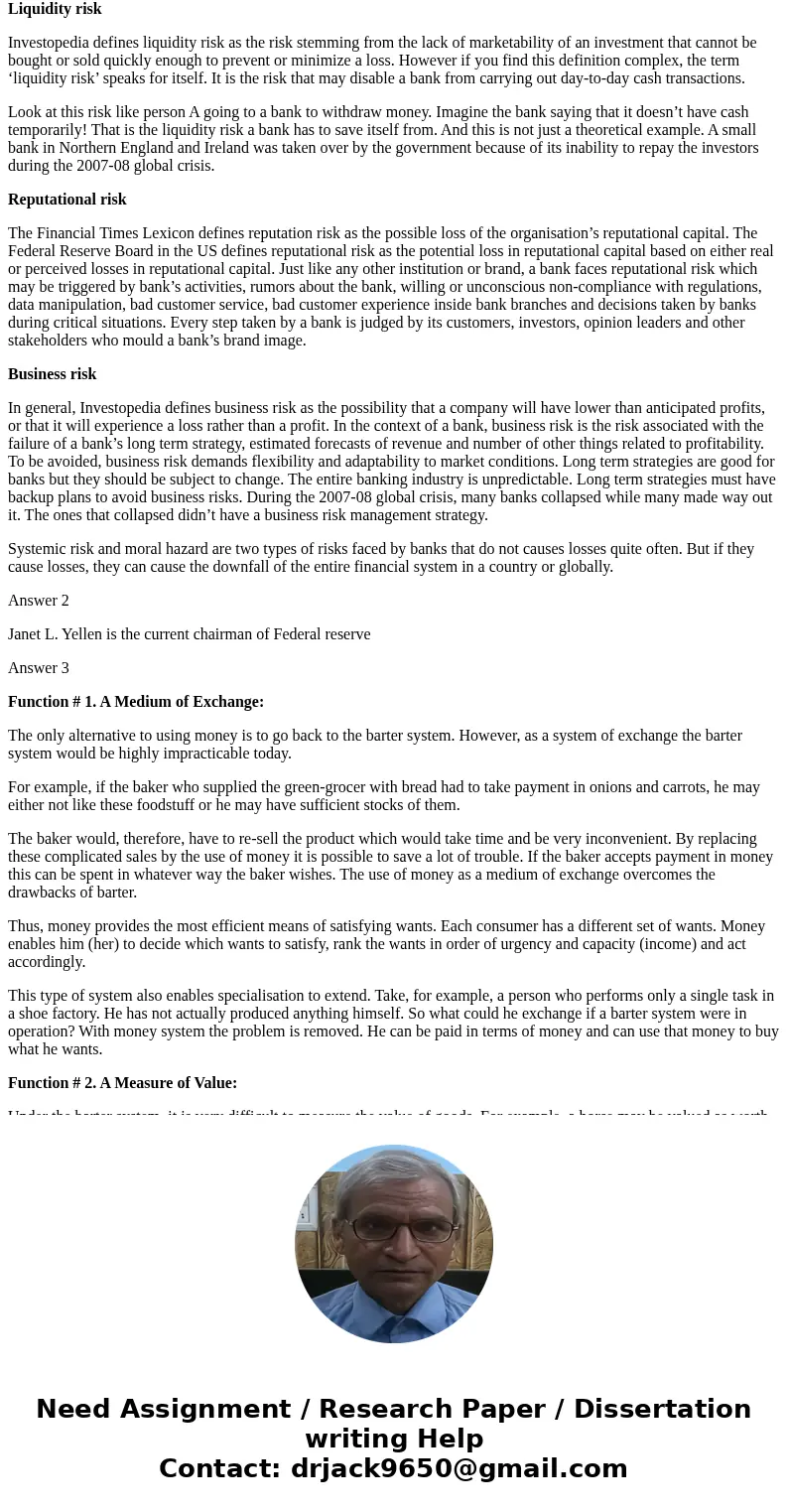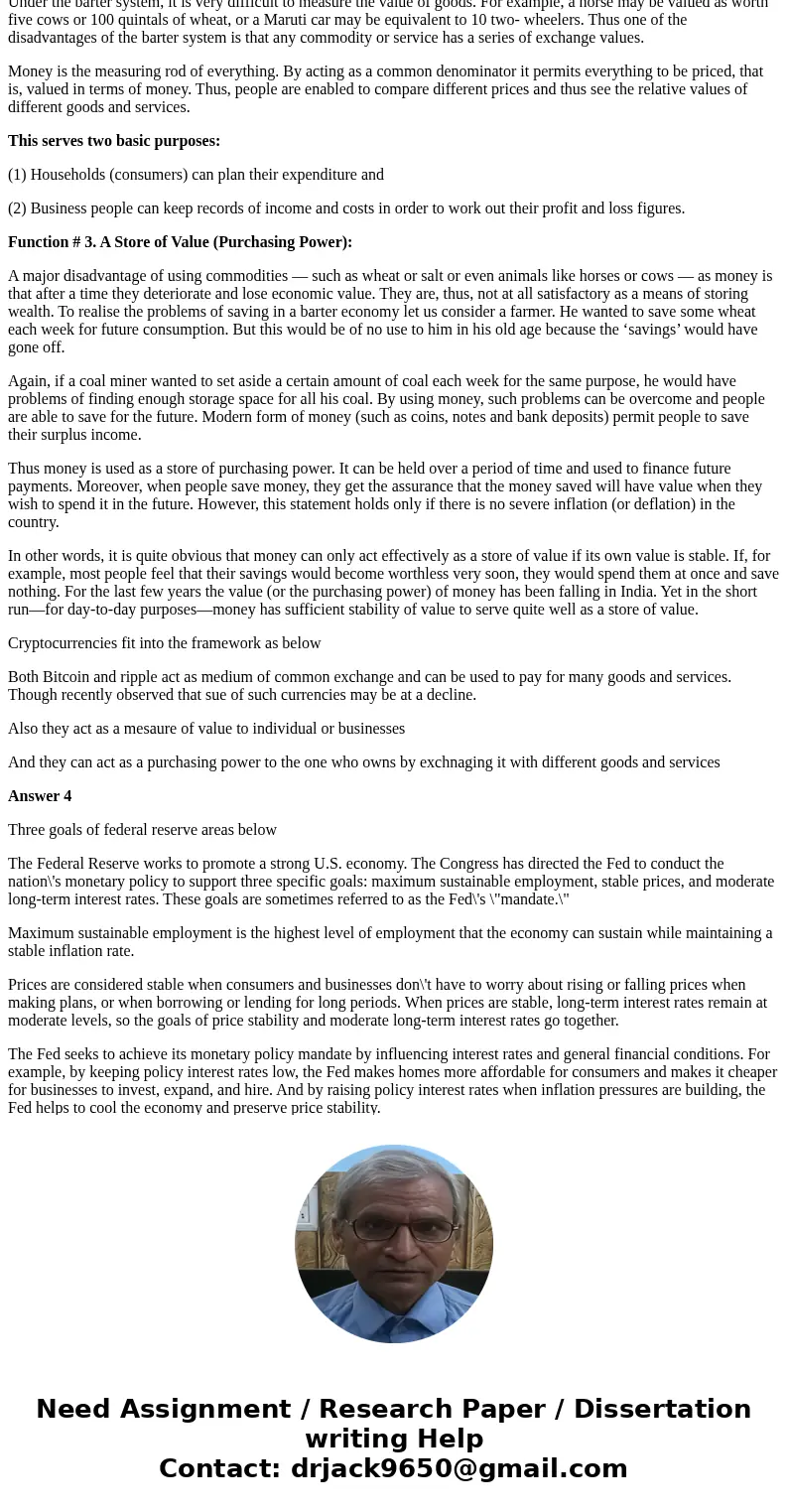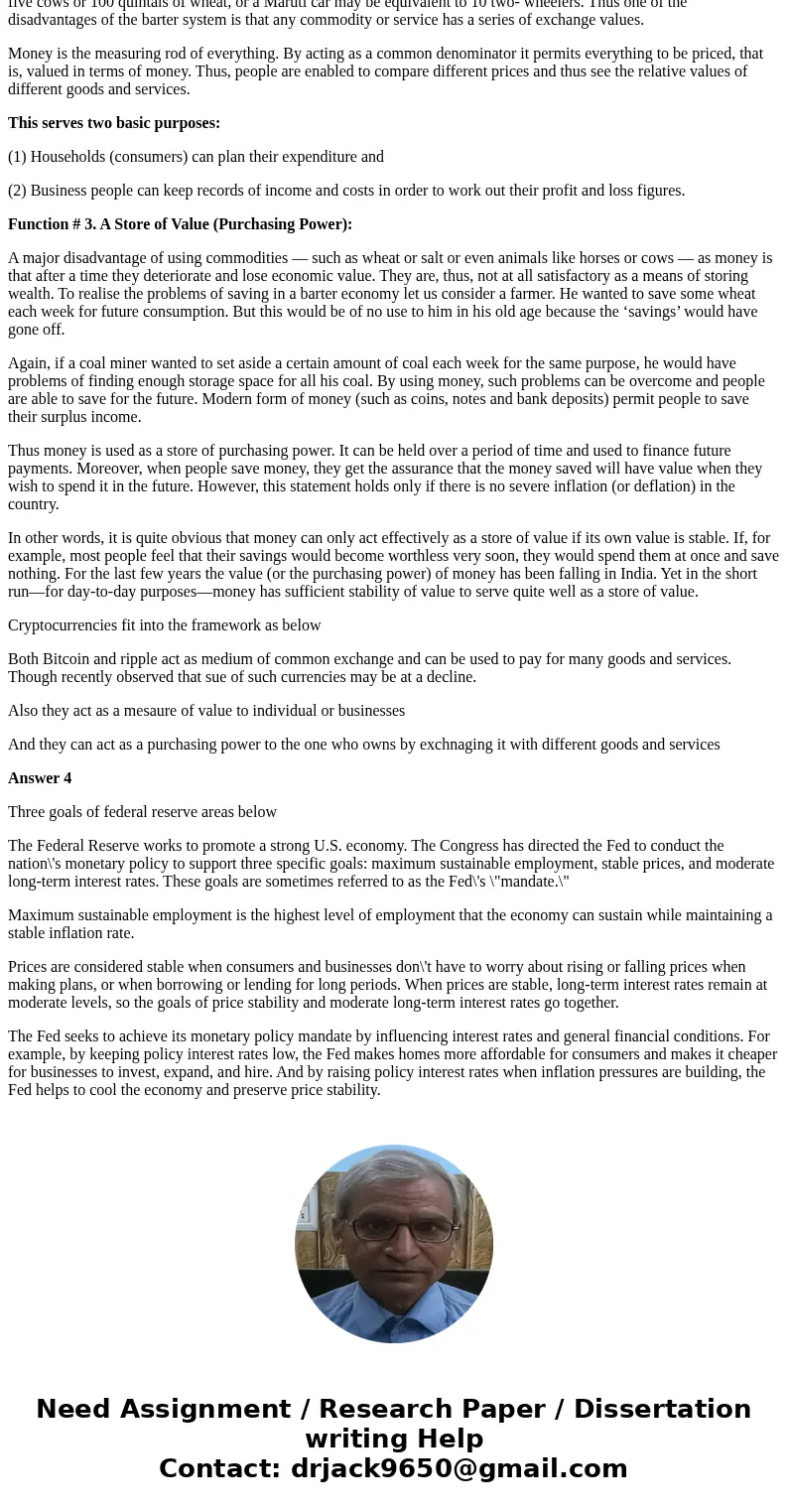832 AM utblackboardcom HW 1The Federal Reserve and Monetary
Solution
Credit risk According to the Bank for International Settlements (BIS), credit risk is defined as the potential that a bank borrower or counterparty will fail to meet its obligations in accordance with agreed terms. Credit risk is most likely caused by loans, acceptances, interbank transactions, trade financing, foreign exchange transactions, financial futures, swaps, bonds, equities, options, and in the extension of commitments and guarantees, and the settlement of transactions. In simple words, if person A borrows loan from a bank and is not able to repay the loan because of inadequate income, loss in business, death, unwillingness or any other reasons, the bank faces credit risk. Similarly, if you do not pay your credit card bill, the bank faces a credit risk.
Hence, to minimize the credit risk on the bank’s end, the rate of interest will be higher for borrowers if they are associated with high credit risk. Factors like unsteady income, low credit score, employment type, collateral assets and others determine the credit risk associated with a borrower. As stated earlier, credit risk can be associated with interbank transactions, foreign transactions and other types of transactions happening outside the bank. If the transaction at one end is successful but unsuccessful at the other end, loss occurs. If the transaction at one end is settled but there are delays in settlement at the other end, there might be lost investment opportunities.
Look at it like person A sending US dollars to his family in India at the rate of 60 INR (Indian Rupee) per dollar. The person B, who is the recipient however receives the payment late and doesn’t get the exchange rate of 60 INR. Instead he receives the money at the exchange rate of 58 INR. This means they incurred a loss in the transaction. Similar situations occur during big transactions in banks. If the bank is not able to settle a transaction at an expected time or during an expected time duration, they may incur a credit risk. However, this kind of risk is called “Settlement Risk” and it is closely associated with credit risk. It depends on the timing of the exchange of value, payment/settlement finality and the role of intermediaries and clearing houses.
While some credit risk is a result of macro forces affecting the economy or specific markets or even specific individuals, there is another important risk that can be classified under credit risk: this is the risk of deliberate fraud that is usually borne by the banks who issue credit products such as credit cards.
Market risk
McKinsey defines market risk as the risk of losses in the bank’s trading book due to changes in equity prices, interest rates, credit spreads, foreign-exchange rates, commodity prices, and other indicators whose values are set in a public market. Bank for International Settlements (BIS) defines market risk as the risk of losses in on- or off-balance sheet positions that arise from movement in market prices. Market risk is prevalent mostly amongst banks who are into investment banking since they are active in capital markets. Investment banks include Goldman Sachs, Bank of America, JPMorgan, Morgan Stanley and many others.
Market risk can be better understood by dividing it into 4 types depending on the potential cause of the risk:
Operational risk
According to the Bank for International Settlements (BIS), operational risk is defined as the risk of loss resulting from inadequate or failed internal processes, people and systems or from external events. This definition includes legal risk, but excludes strategic and reputation risk. Operational risk can widely occur in banks due to human errors or mistakes. Examples of operational risk may be incorrect information filled in during clearing a check or confidential information leaked due to system failure.
Operational risk can be categorized in the following way for a better understanding:
Operational risk may not sound as bad but it is. Operational risk caused the decline of Britain’s oldest banks, Barings in 1995. Since banks are becoming more and more digital and shifting towards information technology to automate their processes, operational risk is an important risk to be taken into consideration by the banks.
Security breaches in which data is compromised could be classified as an operational risk, and recent instances in this area have underlined the need for constant technology investments to mitigate the exposure to such attacks.
Liquidity risk
Investopedia defines liquidity risk as the risk stemming from the lack of marketability of an investment that cannot be bought or sold quickly enough to prevent or minimize a loss. However if you find this definition complex, the term ‘liquidity risk’ speaks for itself. It is the risk that may disable a bank from carrying out day-to-day cash transactions.
Look at this risk like person A going to a bank to withdraw money. Imagine the bank saying that it doesn’t have cash temporarily! That is the liquidity risk a bank has to save itself from. And this is not just a theoretical example. A small bank in Northern England and Ireland was taken over by the government because of its inability to repay the investors during the 2007-08 global crisis.
Reputational risk
The Financial Times Lexicon defines reputation risk as the possible loss of the organisation’s reputational capital. The Federal Reserve Board in the US defines reputational risk as the potential loss in reputational capital based on either real or perceived losses in reputational capital. Just like any other institution or brand, a bank faces reputational risk which may be triggered by bank’s activities, rumors about the bank, willing or unconscious non-compliance with regulations, data manipulation, bad customer service, bad customer experience inside bank branches and decisions taken by banks during critical situations. Every step taken by a bank is judged by its customers, investors, opinion leaders and other stakeholders who mould a bank’s brand image.
Business risk
In general, Investopedia defines business risk as the possibility that a company will have lower than anticipated profits, or that it will experience a loss rather than a profit. In the context of a bank, business risk is the risk associated with the failure of a bank’s long term strategy, estimated forecasts of revenue and number of other things related to profitability. To be avoided, business risk demands flexibility and adaptability to market conditions. Long term strategies are good for banks but they should be subject to change. The entire banking industry is unpredictable. Long term strategies must have backup plans to avoid business risks. During the 2007-08 global crisis, many banks collapsed while many made way out it. The ones that collapsed didn’t have a business risk management strategy.
Systemic risk and moral hazard are two types of risks faced by banks that do not causes losses quite often. But if they cause losses, they can cause the downfall of the entire financial system in a country or globally.
Answer 2
Janet L. Yellen is the current chairman of Federal reserve
Answer 3
Function # 1. A Medium of Exchange:
The only alternative to using money is to go back to the barter system. However, as a system of exchange the barter system would be highly impracticable today.
For example, if the baker who supplied the green-grocer with bread had to take payment in onions and carrots, he may either not like these foodstuff or he may have sufficient stocks of them.
The baker would, therefore, have to re-sell the product which would take time and be very inconvenient. By replacing these complicated sales by the use of money it is possible to save a lot of trouble. If the baker accepts payment in money this can be spent in whatever way the baker wishes. The use of money as a medium of exchange overcomes the drawbacks of barter.
Thus, money provides the most efficient means of satisfying wants. Each consumer has a different set of wants. Money enables him (her) to decide which wants to satisfy, rank the wants in order of urgency and capacity (income) and act accordingly.
This type of system also enables specialisation to extend. Take, for example, a person who performs only a single task in a shoe factory. He has not actually produced anything himself. So what could he exchange if a barter system were in operation? With money system the problem is removed. He can be paid in terms of money and can use that money to buy what he wants.
Function # 2. A Measure of Value:
Under the barter system, it is very difficult to measure the value of goods. For example, a horse may be valued as worth five cows or 100 quintals of wheat, or a Maruti car may be equivalent to 10 two- wheelers. Thus one of the disadvantages of the barter system is that any commodity or service has a series of exchange values.
Money is the measuring rod of everything. By acting as a common denominator it permits everything to be priced, that is, valued in terms of money. Thus, people are enabled to compare different prices and thus see the relative values of different goods and services.
This serves two basic purposes:
(1) Households (consumers) can plan their expenditure and
(2) Business people can keep records of income and costs in order to work out their profit and loss figures.
Function # 3. A Store of Value (Purchasing Power):
A major disadvantage of using commodities — such as wheat or salt or even animals like horses or cows — as money is that after a time they deteriorate and lose economic value. They are, thus, not at all satisfactory as a means of storing wealth. To realise the problems of saving in a barter economy let us consider a farmer. He wanted to save some wheat each week for future consumption. But this would be of no use to him in his old age because the ‘savings’ would have gone off.
Again, if a coal miner wanted to set aside a certain amount of coal each week for the same purpose, he would have problems of finding enough storage space for all his coal. By using money, such problems can be overcome and people are able to save for the future. Modern form of money (such as coins, notes and bank deposits) permit people to save their surplus income.
Thus money is used as a store of purchasing power. It can be held over a period of time and used to finance future payments. Moreover, when people save money, they get the assurance that the money saved will have value when they wish to spend it in the future. However, this statement holds only if there is no severe inflation (or deflation) in the country.
In other words, it is quite obvious that money can only act effectively as a store of value if its own value is stable. If, for example, most people feel that their savings would become worthless very soon, they would spend them at once and save nothing. For the last few years the value (or the purchasing power) of money has been falling in India. Yet in the short run—for day-to-day purposes—money has sufficient stability of value to serve quite well as a store of value.
Cryptocurrencies fit into the framework as below
Both Bitcoin and ripple act as medium of common exchange and can be used to pay for many goods and services. Though recently observed that sue of such currencies may be at a decline.
Also they act as a mesaure of value to individual or businesses
And they can act as a purchasing power to the one who owns by exchnaging it with different goods and services
Answer 4
Three goals of federal reserve areas below
The Federal Reserve works to promote a strong U.S. economy. The Congress has directed the Fed to conduct the nation\'s monetary policy to support three specific goals: maximum sustainable employment, stable prices, and moderate long-term interest rates. These goals are sometimes referred to as the Fed\'s \"mandate.\"
Maximum sustainable employment is the highest level of employment that the economy can sustain while maintaining a stable inflation rate.
Prices are considered stable when consumers and businesses don\'t have to worry about rising or falling prices when making plans, or when borrowing or lending for long periods. When prices are stable, long-term interest rates remain at moderate levels, so the goals of price stability and moderate long-term interest rates go together.
The Fed seeks to achieve its monetary policy mandate by influencing interest rates and general financial conditions. For example, by keeping policy interest rates low, the Fed makes homes more affordable for consumers and makes it cheaper for businesses to invest, expand, and hire. And by raising policy interest rates when inflation pressures are building, the Fed helps to cool the economy and preserve price stability.




 Homework Sourse
Homework Sourse